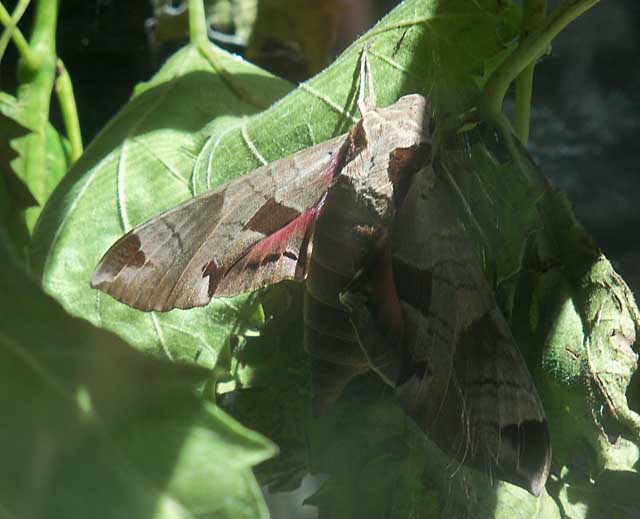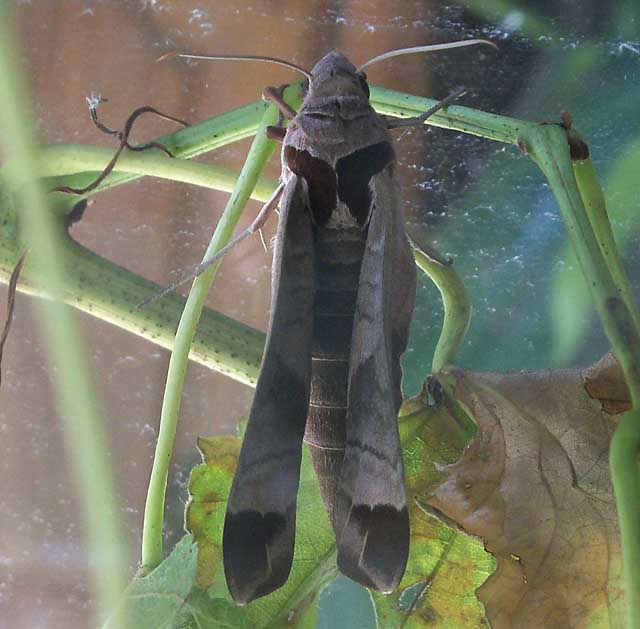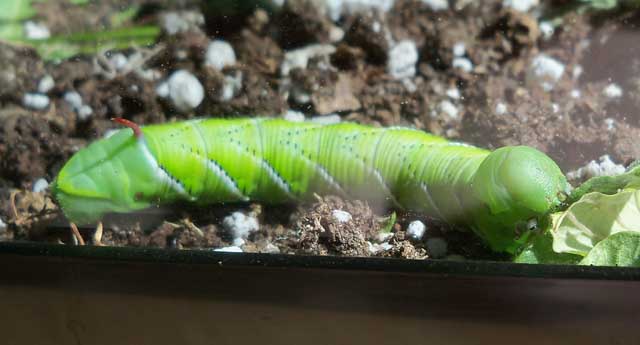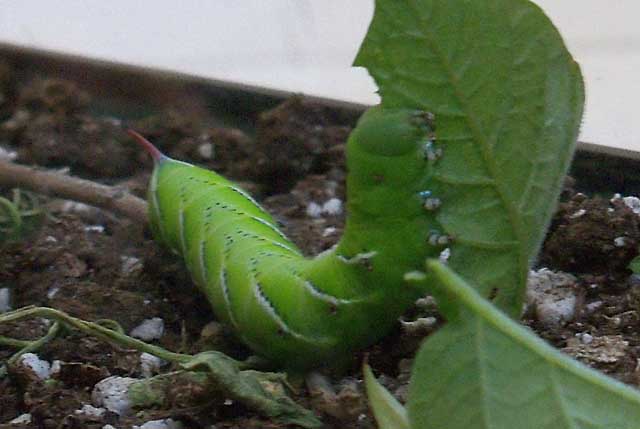San Joaquin County, California
Sphingidae
Eumorpha achemon, San Joaquin County, California,
August 12, 2011, from found larva, courtesy of Melissa Humphreys.
|
|
Created/dedicated as per personal communication with Melissa Humphreys, August 12, 2011 Updated as per James P. Tuttle's The Hawk Moths of North America, August 13, 2011 Updated as per BAMONA, August 13, 2011 |

Eumorpha achemon, San Joaquin County, California,
August 12, 2011, from found larva, courtesy of Melissa Humphreys.
I believe it is more likely Smerinthus ophthalica rather than Smerinthus cerisyi that flies in San Joaquin County.
Judy Rebeiro recently (late March 2017) ecountered a female that deposited some fertile eggs. If she is successful in rearing some to mature larvae stage perhaps we will know for sure whether they are opthalmica or cerisy. It is hoped that this checklist, with the thumbnails and notes, will help you quickly identify the moths you have encountered.
A WO" after the species name indicates that I have no confirmed reports of this species in your county, but I (William Oehlke) expect that this moth is present.
This page is dedicated to Melissa Humphreys, San Joaquin County,
California. Jewelle provides the images of Eumorpha achemon (adult moth) and Manduca sexta (larva) on top and bottom of this page.
Melissa writes, August 12, 2011, "I live in the Central Valley in California (San Joaquin County). I found a tomato hornworm in my garden eating the grape leaves so
I brought it inside and took care of it so the birds wouldn't get it. It is now a moth.
When I look up pictures for the tomato hornworm moth it looks completely different, and pictures of the pandorus worm looks completely different from the
caterpillar I had. I'm a little confused.
"Also, is it common for these little guys to be picky eaters? I found a second worm in my garden after the first had already entered pupa stage.
The first liked grape leaves but the second won't eat anything but potato leaves. It's really picky."
I reply, "Hi Jewelle,
"The caterpillar eating the grape leaves was not a tomato hornworm. They do not eat grape leaves. It was most likely a caterpillar of Eumorpha achemon.
I suspect the moth is also an Eumorpha achemon (bottom of page). The Pandorus Sphinx does not fly in California.
"If you or one of your friends has a camera and can take some pictures and send them to me as jpg attachments, I can make better determinations.
"Different Sphingidae species do eat different foodplants, but often a single species will eat more than one foodplant.
"I have just received your pictures. The moth is Eumorpha achemon. It came from the "fat caterpillar" without a horn that was eating grape foliage.
The caterpillar with the red horn (top of page) is Manduca sexta."

Eumorpha achemon inflating, San Joaquin County, California,
August 12, 2011, from found larva, courtesy of Jewelle.
When the moths first emerge from their pupae, their wings are short, stubby and quite soft. The moth needs to climb and hang to that it can pump fluid into its wing veins so the wings can properly inflate and then stiffen for flight. Jewelle has sent an image (above) with the wings almost completely inflated. The wings probably would have been only 1/4 to 1/3 as long when the moth first broke forth from its pupa.
A green BAMONA indicates the moth is reported on the BAMONA website and/or in Moths of Western North America, #2. Distribution of Sphingidae of Western North America, revised, an excellent little booklet available through Paul Opler.
Please help me develop this list with improved, documented accuracy by sending sightings (species, date, location), preferably with an image, via email to Bill Oehlke.
Please also forward sightings to BAMONA, an excellent online resource.
Sphinginae subfamily
Smerinthini Tribe:
Smerinthus ophthalmica probably replaces cerisyi in northern and central California.
Macroglossinae subfamilyDilophonotini Tribe:
Philampelini Tribe:
Macroglossini Tribe:
|

Manduca sexta fifth instar, San Joaquin County, California,
feeding on potato foliage, August 12, 2011, courtesy of Melissa Humphreys.

Manduca sexta fifth instar, San Joaquin County, California,
feeding on potato foliage, August 12, 2011, courtesy of Melissa Humphreys.
Enjoy some of nature's wonderments, giant silk moth cocoons. These cocoons are for sale winter and fall. Beautiful Saturniidae moths will emerge the following spring and summer. Read Actias luna rearing article. Additional online help available.
Use your browser "Back" button to return to the previous page.
This page is brought to you by Bill Oehlke and the WLSS. Pages are on space rented from Bizland. If you would like to become a "Patron of the Sphingidae/Catocala Sites", contact Bill.
Please send sightings/images to Bill. I will do my best to respond to requests for identification help.
 Show appreciation for this site by clicking on flashing butterfly to the left. The link will take you to a page with links to many insect sites. |